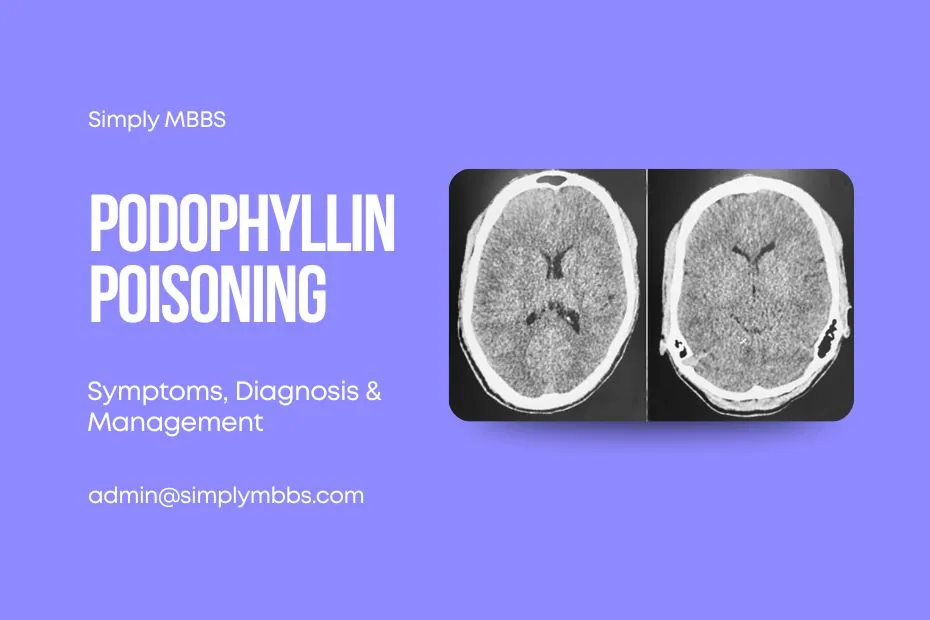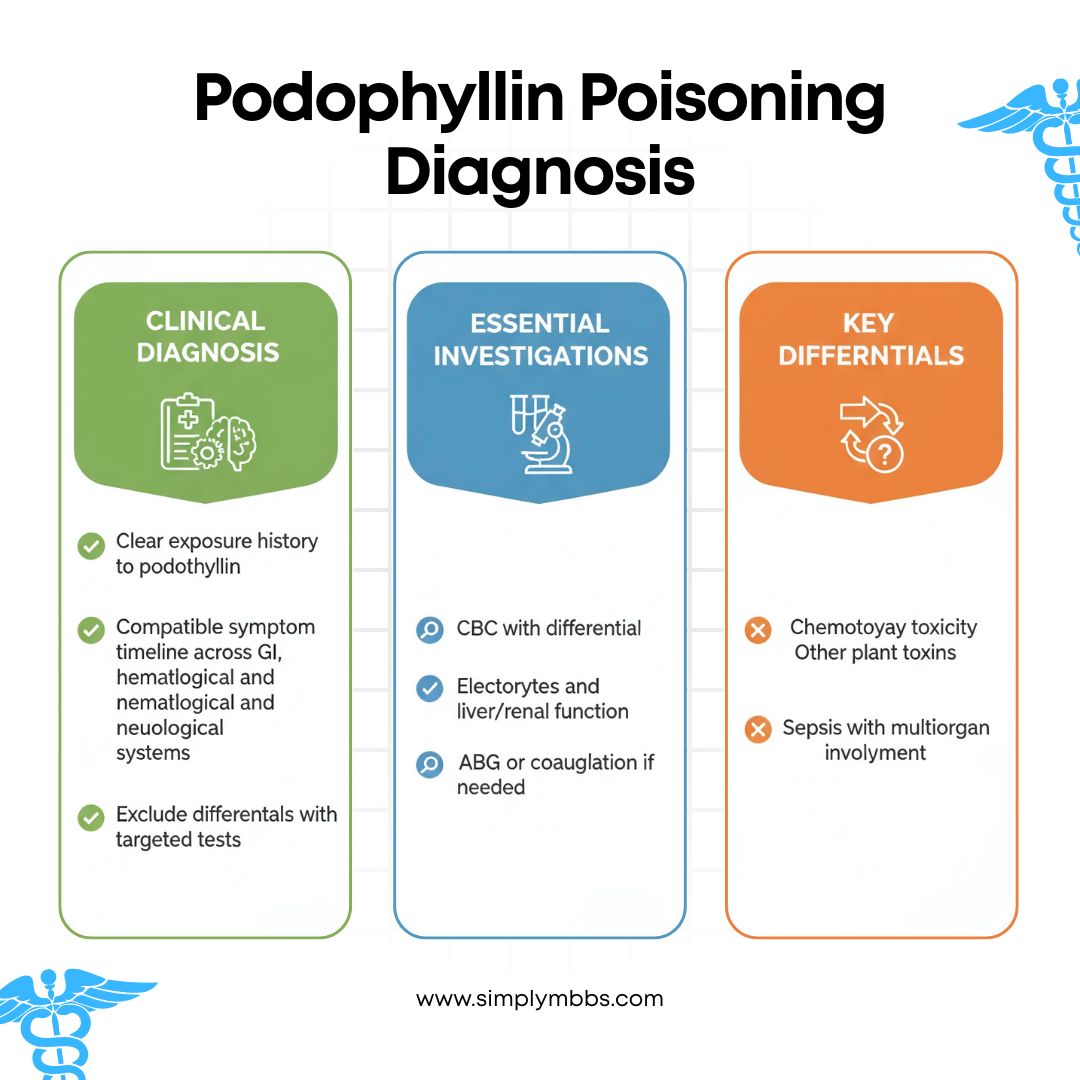Concise, clinically focused review of podophyllin poisoning for medical students: recognition, diagnosis, and evidence‑based management. podophyllin poisoning — key symptoms and management at a glance.
Overview of podophyllin poisoning
Podophyllin poisoning results from excessive exposure to podophyllin or podophyllotoxin. Consequently, it causes a characteristic triad of gastrointestinal, hematological, and neurological toxicity. Although topical therapy is still used for warts, misuse or overdose may rapidly lead to systemic effects.
- Sources: Podophyllum species resins; compounded topical preparations.
- Key mechanism: Potent mitotic inhibitor → metaphase arrest.
- High‑risk scenarios: Large surface application, occlusion, damaged skin, ingestion, pediatric exposure.
For context, review related emergencies such as methanol poisoning and anaphylactic shock.
Pathophysiology in podophyllin poisoning
Cellular mechanisms
- Podophyllotoxin binds tubulin → prevents microtubule assembly → mitotic arrest.
- Topoisomerase II interference → DNA strand breaks and chromosomal damage.
Systemic effects
- GI mucosal injury → severe enteritis and fluid loss.
- Bone marrow suppression → leukopenia, thrombocytopenia, anemia.
- Neurotoxicity → encephalopathy, peripheral neuropathy, ataxia.
Clinical features of podophyllin poisoning
Acute (0–24 h)
- Nausea, vomiting, abdominal pain, watery diarrhea.
- Local chemical burns at application site.
- Early confusion or drowsiness.
Intermediate (1–7 days)
- Bloody diarrhea, dehydration, electrolyte imbalance.
- Progressive cytopenias on CBC.
- Peripheral neuropathy, weakness, ataxia.
Late (>7 days)
- Severe marrow suppression → infection and bleeding risk.
- Hepatic and renal dysfunction.
- Respiratory depression, rarely paralysis and coma.
Diagnosis of podophyllin poisoning
Clinical diagnosis
- Clear exposure history to podophyllin or podophyllotoxin.
- Compatible symptom timeline across GI, hematological, and neurological systems.
- Exclude differentials with targeted tests.
Essential investigations
- CBC with differential (track nadirs).
- Electrolytes, renal and liver function tests.
- ABG if respiratory compromise; coagulation profile if bleeding.
- Urinalysis; consider cultures if febrile.
Key differentials
- Chemotherapy toxicity (clear oncology history).
- Other plant toxins (different toxidromes).
- Sepsis with multiorgan involvement.
- Guillain–Barré syndrome for neuropathy‑predominant cases.
Management of podophyllin poisoning
Immediate steps (ABC first)
- Stabilize airway, breathing, and circulation.
- Remove contaminated clothing; thoroughly irrigate skin.
- Start IV fluids and correct electrolytes promptly.
Decontamination
- Activated charcoal if ingestion within 1–2 hours and airway protected.
- Gastric lavage only in exceptional, very recent life‑threatening ingestions.
Supportive and targeted care
- Aggressive fluid therapy; early nutrition if prolonged GI dysfunction.
- Hematologic support: transfuse as indicated; consider G‑CSF for severe neutropenia.
- Strict infection surveillance; implement isolation if profoundly immunosuppressed.
- Neurologic care: analgesia for neuropathic pain; physical therapy; ventilatory support if required.
No specific antidote exists; therefore, management remains supportive and multidisciplinary.
Also read: hypovolemic shock, Widal test interpretation, stiff person syndrome, brachial plexus anatomy, and lesser sac anatomy for broader exam prep.
Last‑minute exam checklist: podophyllin poisoning
- Say “mitotic arrest via tubulin binding” whenever asked mechanism.
- Quote triad: GI − marrow − neuro.
- Order CBC trend, LFT/RFT, electrolytes; watch for nadir days 3–7.
- Start IV fluids early; prevent infections; consider G‑CSF if severe neutropenia.
- No antidote — emphasize supportive, multidisciplinary care.
Model Q&A (exam‑practical)
Q1. Explain the mechanism of toxicity in podophyllin poisoning.
Answer: Podophyllotoxin binds tubulin, halting microtubule assembly and arresting mitosis in metaphase. Additionally, it interferes with topoisomerase II, producing DNA strand breaks. Rapidly dividing tissues (GI mucosa, bone marrow) are most affected, which explains the clinical triad.
Q2. A 25‑year‑old presents 48 h after topical application with vomiting, confusion, WBC 2,000/µL and platelets 50,000/µL. Outline management.
Answer: Stabilize ABC; decontaminate skin; begin IV fluids and electrolyte correction; daily CBC and metabolic panels; infection surveillance and isolation if needed; transfuse as indicated; consider G‑CSF for severe neutropenia; provide antiemetics, nutrition, and physiotherapy; escalate to ICU if neurological or respiratory compromise develops.
Q3. Differentiate podophyllin poisoning from viral gastroenteritis and chemotherapy toxicity.
Answer: Compared with viral gastroenteritis, podophyllin poisoning shows marrow suppression and neurotoxicity. In contrast to chemotherapy toxicity, there is no cancer treatment history and exposure centers on topical/ingested resin. Timeline correlation with exposure helps confirm the diagnosis.
FAQ: podophyllin poisoning
How soon do symptoms of podophyllin poisoning appear?
Usually within hours: GI symptoms appear first (2–12 h), hematologic changes follow (24–72 h), and neurological features emerge over 2–7 days.
Is podophyllin poisoning always fatal?
No. Prognosis depends on dose and timing of care. Early recognition and supportive management substantially improve outcomes.
Can podophyllin poisoning cause permanent deficits?
Yes, severe cases can leave persistent peripheral neuropathy and weakness; however, many patients recover with appropriate care.
What should clinicians do if overdose is suspected?
Stop exposure immediately; stabilize ABC; initiate fluids and labs (CBC, CMP); monitor closely; consult clinical toxicology or poison control promptly.
What is the difference between podophyllin and podophyllotoxin?
Podophyllin is a crude resin containing multiple compounds, while podophyllotoxin is the purified active agent and is more potent.
References and further reading
- NCBI Bookshelf: Toxicology overviews.
- PubMed: Podophyllin poisoning articles.
- Related on SimplyMBBS: Methanol poisoning, Anaphylactic shock, Hypovolemic shock, Widal test, Stiff person syndrome, Brachial plexus anatomy, Lesser sac anatomy.


